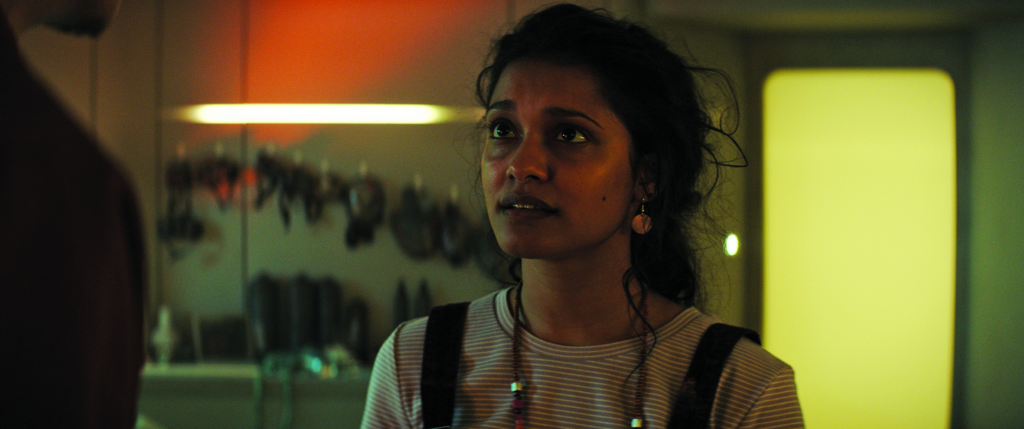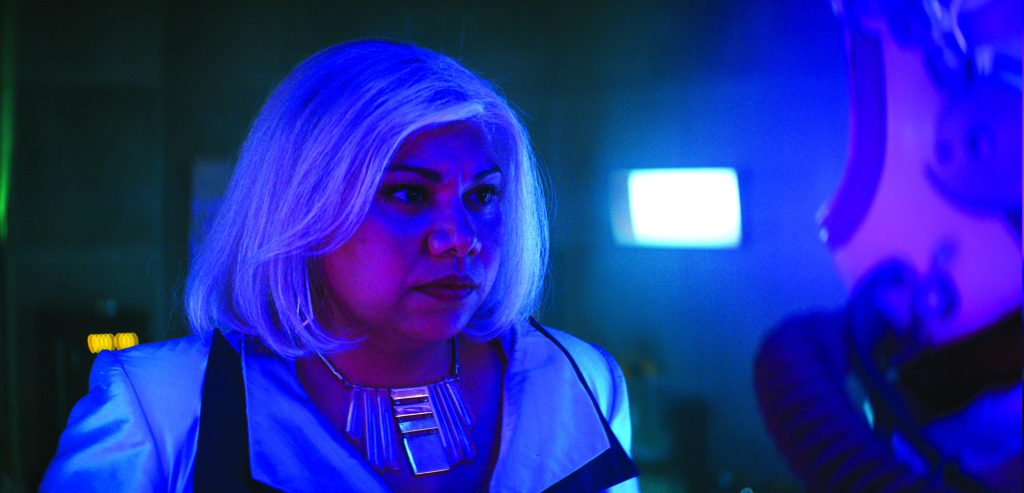Seth Larney’s 2020 science fiction thriller 2067 begins amid what might be the climax of another film: in the last city on Earth, a nuclear explosion is imminent, and mere seconds remain to prevent catastrophe. And yet, the characters are not alarmed. In this apocalyptic near-future vision of a time when Earth’s plant life is extinct and synthetic oxygen has become currency (ATMs have been replaced with ‘O2TMs’, at which people fill up their wearable tanks), teetering on the precipice of death has become routine. After a year in which international and intranational border closures, lockdowns, and face masks became the new normal, it will perhaps be a little easier for viewers to grasp how humanity could so quickly acclimatise to the previously unimaginable.
Premiering locally at the 2020 Adelaide Film Festival, 2067 is an ambitious Australian film made for an international audience; its makers are apparently keen to contribute to the urgent global conversation about anthropogenic climate change and the hope that we can change the planet’s fate. The film was slated to show ‘on at least 10,000 screens’ in China;[1]Don Groves, ‘Seth Larney’s 2067 to Get Wide Release in China’, IF.com.au, 20 March 2019, <https://www.if.com.au/seth-larneys-2067-to-get-wide-release-in-china/>, accessed 10 March 2021. however, presumably due to the pandemic, this has, at the time of writing, not yet eventuated. The film’s cinematic release in the US in October was, by contrast, almost non-existent, but achieved a wider viewership by simultaneously launching on iTunes and Amazon Prime Video (it later became available to local audiences via Netflix Australia in February this year). While it is difficult to acquire precise audience data for films on streaming services, 2067 was the highest-ranking independent film (and second-most-popular title overall) on the iTunes digital chart in February 2021,[2]See ‘The Top 10 Movies on the iTunes Store’, ABC News (US), 10 February 2021, <https://abcnews.go.com/Entertainment/wireStory/top-10-movies-itunes-store-75779645>, accessed 10 March 2021. and currently has over 5000 votes on the Internet Movie Database (at present, more than any of the major Australian features released over the summer).[3]By way of comparison, as of 10 March 2021, Penguin Bloom (Glendyn Ivin, 2020) has 4740 ratings; Occupation: Rainfall (Luke Sparke, 2020), 2678; The Dry (Robert Connolly, 2020), 2071; and High Ground (Stephen Maxwell Johnson, 2020), 933.

Australian filmmaker Larney’s background is in post-production, visual effects and digital assets, having worked on major film franchises such as The Matrix, Star Wars, The Chronicles of Narnia and X-Men;[4]Larney has previously been a crew member on The Matrix Reloaded and The Matrix Revolutions (both directed by Lana & Lilly Wachowski, 2003), Star Wars: Episode III – Revenge of the Sith (George Lucas, 2005), Superman Returns (Bryan Singer, 2006), and The Chronicles of Narnia: The Voyage of the Dawn Treader (Michael Apted, 2010). He has directed short films and the SBS series Hipsters, as well as behind-the-scenes segments for X-Men Origins: Wolverine (Gavin Hood, 2009)and The Lego Movie (Christopher Miller & Phil Lord, 2014). 2067, his feature debut as writer-director, is a passion project he had been developing for fifteen years. In several promotional interviews for the film, Larney recalls that he started writing the script after hearing some disturbing statistics: that the Amazon was being logged at the rate of three football fields a minute; and that it accounts for 25 per cent of the world’s breathable oxygen.[5]See, for example, Dov Kornits, ‘Seth Larney: 2067 Is Now’, FilmInk,4 October 2020, <https://www.filmink.com.au/seth-larney-2067-is-now/>; and Belinda Quinn, ‘2067 Director Seth Larney: “The Power of Story Is More Important than It’s Ever Been”’, NME, 19 February 2021 <https://www.nme.com/en_au/features/2067-director-seth-larney-australia-sci-fi-climate-change-2883428>, both accessed 10 March 2021. Although the latter is a popular myth,[6]See Katarina Zimmer, ‘Why the Amazon Doesn’t Really Produce 20% of the World’s Oxygen’, National Geographic, 29 August 2019, <https://www.nationalgeographic.com/environment/2019/08/why-amazon-doesnt-produce-20
-percent-worlds-oxygen/>, accessed 10 March 2021. deforestation certainly contributes to climate change and loss of biodiversity. Larney explains how he grew up in a forested area in the Northern Rivers region of New South Wales and wrote the film with the intention that major parts of it would be filmed there (for what is, otherwise, predominantly a studio film). However, unprecedented drought meant that the old-growth forest was no longer the haven of lush green it had once been, and much of it was brown and dead by the time the film was ready to be shot. He ultimately flew his crew 1500 kilometres to find a viridescent pocket of Australian woodland suitable for filming, but managed to keep in one helicopter shot of his childhood forest, which was jeopardised by smoke because sections beyond the horizon were on fire.[7]See ‘Hoping for a Better Future’, The Drawing Room, Radio National, 7 October 2020, <https://www.abc.net.au/radionational/programs/drawingroom/hoping-for-a-better-future/12740758>, accessed 10 March 2021. After the devastating 2019–2020 Australian bushfire season that destroyed 17 million hectares of plant and animal habitat,[8]Commonwealth of Australia, ‘2019–20 Australian Bushfires – Frequently Asked Questions: A Quick Guide’, 12 March 2020, <https://www.aph.gov.au/About_Parliament/Parliamentary_Departments/Parliamentary_Library/pubs/rp/rp1920/Quick_Guides/AustralianBushfires>, accessed 10 March 2021. 2067’s opening visual-effects sequence of whole continents ablaze seems hauntingly realistic. As such, the film presents a highly credible forecast for the non-future of humanity.
Like so many works in the historically masculinist tradition of science fiction, Larney’s film is primarily concerned with paternity and fraternity.
A man’s world
Kodi Smit-McPhee plays protagonist Ethan, a tunnel worker called on to save the world by travelling to the future in a time machine built by his late father, professor Richard (Aaron Glenane). Richard is dead, but we see in flashbacks that, even when alive, he was too absorbed in his work as a quantum physicist to be present for his son. Ethan’s mother, Selene (Leeanna Walsman), in contrast, is apparently a stay-at-home wife and mother, without a career of her own; in one flashback sequence, the camera pans past Richard’s PhD diploma inside their apartment to reveal her putting away dishes in the kitchen. Science, here, is depicted as being as gendered in the future as it is in the present: when Richard tells Ethan (played as a child by Finn Little) that he is ‘going to grow up to be someone very important’, his son asks if he means a ‘science man’ like him. Richard’s second-in-command at the laboratory, Billy (Damian Walshe-Howling), is also male; there are some lab-coat-wearing women visible in the background, but that is where they stay.
While Ethan experiences flashbacks of his mother’s death – she is killed in an alleyway robbery reminiscent of the scenes in which Bruce Wayne is orphaned in various Batman films – we see no moments from her life to parallel the poignant conversations he remembers with his father. The character of Selene is, thus, little more than a victim, merely serving as an accessory to enhance viewers’ understanding of Ethan’s feelings towards his father; as he says at one point, ‘If he’d just been there instead of chasing fucking rainbows, my mother would still be alive.’

Ethan’s ‘sick wife’, Xanthe (Sana’a Shaik), is likewise disempowered. Both Selene and Xanthe conform to the ‘women in refrigerators’ trope,[9]See Larissa Irankunda, ‘The Lukewarm Appeal of the “Women in Refrigerators” Trope’, The Mary Sue,28 October 2020, <https://www.themarysue.com/women-in-refrigerators-trope-genre-classics/>, accessed 10 March 2021. whereby the tragedy of a female character’s trauma provokes a male character’s angst and emotional development. Although Xanthe is a botanical-history teacher, the door of her classroom reads – in stark contrast to the prestige of Richard’s title of ‘professor’ – ‘Mrs Xanthe Whyte’, her honorific conveying nothing other than her gender and marital status. The film also implies that it is her husband’s earning capacity as a tunnel worker – and not her own profession – that can pay for her access to high-grade oxygen. In all these respects, she exists as a plot device to incite Ethan’s protective instincts and propel him on his heroic quest: he is on a mission to ‘save’ Xanthe, and he is desperate not to ‘abandon’ her. Despite her own expertise, there is never any suggestion that she might be a ‘science woman’, or capable of altering her own destiny. Instead, she is infantilised as a dependant.
Of the female characters in the film, the only one granted any agency is Regina (Deborah Mailman), CTO of particle research at oxygen manufacturer Chronicorp, and the film’s primary antagonist. Although Mailman and Shaik – both women of colour – offer some diversity to the cast, the racial politics of casting Mailman as a villain and Shaik as a victim (with the white Smit-McPhee playing her saviour) are questionable. Ultimately, these non-white female characters are undeveloped, while much more screen time is afforded to their white male counterparts.
One of the key production companies behind 2067 is Arcadia, which was co-founded by Larney’s wife, Lisa Shaunessy (who also serves as a producer on the film[10]Shaunessy shares this credit with Futurism Studios’ Jason Taylor and KOJO Entertainment’s Kate Croser.), to champion film projects prioritising female writers, directors and protagonists.[11]Jackie Keast, ‘Arcadia Revs Up with Remit to Produce Films by and About Women’, IF.com.au, 24 March 2017, <https://www.if.com.au/arcadia-revs-up-with-remit-to-produce-films
-by-and-about-women/>, accessed 10 March 2021. None of these are served by 2067. Instead, like so many works in the historically masculinist tradition of science fiction, Larney’s film is primarily concerned with paternity and fraternity.[12]For further discussion of this tradition, see Bronwyn Lovell, ‘Science Fiction’s Women Problem’, The Conversation,16 September 2016, <https://theconversation.com/friday-essay-science-fictions-women-problem-58626>, accessed 10 March 2021.

Future, past and present
Central to 2067 is the relationship between Ethan and Jude (Ryan Kwanten). The two men call each other ‘bro’[13]Although Kwanten is, like the rest of the main cast, Australian, his character speaks with an American accent, presumably in a bid to appeal to international audiences. and Jude often addresses Ethan as ‘little brother’; ‘I am your family,’ the former tells the latter in one scene. As his name suggests, Jude is an archetypal ‘Judas’ character, and the pair’s shifting dynamic serves not only themes of brotherhood, trust and deception, but also an allegory of the conflicts between faith and fate, free will and determinism.
More specifically, this aspect of the narrative represents the struggle every individual faces when confronted with the seeming inevitability of ecological collapse on this planet. Is it worth resisting a future that may be ‘already written’? Are we as a species ‘already dead’? Instead of indulging in such apathy-inducing fatalism, 2067 chooses to deliver a message of hope: that one’s actions are far from inconsequential, and that it is not too late to change the fate of humanity and our relationship with the environment. For all it lacks in its handling of gender, the film is admirable as a work of environmental activism.
Like all independent screen projects, 2067 is the product of a dedicated and determined community of creatives and supporters.[14]The film received funding from Screen Australia, the South Australian Film Corporation, Create NSW, the Screen NSW Regional Filming Fund and the Adelaide Film Festival Investment Fund. It was also crowdfunded through a Pozible campaign under the working title Subject 14; see ‘Subject 14 – the Movie’ Pozible campaign page, <https://www.pozible.com/project/187298/>, accessed 10 March 2021. Despite the film’s low budget, Larney’s expertise in digital effects makes it a visually impressive and technically accomplished production. In particular, the music by Kenneth Lampl and Kirsten Axelholm – a 110-minute symphony within which characters have their own themes, in the classic tradition of John Williams, whom Lampl was at one time instructed by – is epic. Their operatic score dominates dramatic moments, and is a ubiquitous presence in the film; it also pays homage to various iconic science fiction films, even employing the same synthesiser as the one featured in the soundtrack to Blade Runner 2049 (Denis Villeneuve, 2017).[15]Evana Ho, ‘ANU Composition Duo Score Hit Australian Film’, media release, Australian National University, 8 December 2020,<https://cass.anu.edu.au/news/anu-composition-duo-score-hit-australian-film>, accessed 10 March 2021.

The film calls attention to its genre in a number of other ways. Its form echoes its content: 2067’s time-travel narrative is interspersed with flashbacks that themselves portray time as a series of repetitions, loops and fragments. And the film itself is lent a sense of deja vu through its use of familiar science fiction motifs: the gritty future metropolis with its dark alleyways, evoking the aesthetic of Blade Runner (Ridley Scott, 1982); the rise of respiratory distress and related deaths, reminiscent of those caused by climate-change-induced dust storms in Interstellar (Christopher Nolan, 2014); Jude’s confrontation with a recording of his future actions that are in conflict with his self-concept, à la Minority Report (Steven Spielberg, 2002); Ethan’s sacrificial venture into a depressurised cell, recalling Spock’s (Leonard Nimoy) radiation-chamber scene in Star Trek II: The Wrath of Khan (Nicholas Meyer, 1982); the corporate callousness of Chronicorp, redolent of ‘the company’ from Alien (Scott, 1979).
Above all, the influence of Star Wars (various directors, 1977–2019) is particularly clear. Even recent additions to that franchise are obsessed with the legacy of paternal heritage, from which the films’ conflicted protagonists nevertheless gain their power and importance: Kylo Ren (Adam Driver) is the grandson of Anakin Skywalker (Jake Lloyd / Hayden Christensen / David Prowse); Jyn (Felicity Jones) is the daughter of Galen (Mads Mikkelsen); and Rey (Daisy Ridley) is descended from Emperor Palpatine (Ian McDiarmid). In Larney’s film, likewise, Ethan is only narratively significant due to the position previously held by his professor father. Through this plot point and more, 2067 ultimately reads as a remix of science fiction’s mostly white, mostly male classic cinematic canon. It is a futuristic vision steeped in nostalgia, yearning for a yesterday that no longer exists.
Endnotes
| 1 | Don Groves, ‘Seth Larney’s 2067 to Get Wide Release in China’, IF.com.au, 20 March 2019, <https://www.if.com.au/seth-larneys-2067-to-get-wide-release-in-china/>, accessed 10 March 2021. |
|---|---|
| 2 | See ‘The Top 10 Movies on the iTunes Store’, ABC News (US), 10 February 2021, <https://abcnews.go.com/Entertainment/wireStory/top-10-movies-itunes-store-75779645>, accessed 10 March 2021. |
| 3 | By way of comparison, as of 10 March 2021, Penguin Bloom (Glendyn Ivin, 2020) has 4740 ratings; Occupation: Rainfall (Luke Sparke, 2020), 2678; The Dry (Robert Connolly, 2020), 2071; and High Ground (Stephen Maxwell Johnson, 2020), 933. |
| 4 | Larney has previously been a crew member on The Matrix Reloaded and The Matrix Revolutions (both directed by Lana & Lilly Wachowski, 2003), Star Wars: Episode III – Revenge of the Sith (George Lucas, 2005), Superman Returns (Bryan Singer, 2006), and The Chronicles of Narnia: The Voyage of the Dawn Treader (Michael Apted, 2010). He has directed short films and the SBS series Hipsters, as well as behind-the-scenes segments for X-Men Origins: Wolverine (Gavin Hood, 2009)and The Lego Movie (Christopher Miller & Phil Lord, 2014). |
| 5 | See, for example, Dov Kornits, ‘Seth Larney: 2067 Is Now’, FilmInk,4 October 2020, <https://www.filmink.com.au/seth-larney-2067-is-now/>; and Belinda Quinn, ‘2067 Director Seth Larney: “The Power of Story Is More Important than It’s Ever Been”’, NME, 19 February 2021 <https://www.nme.com/en_au/features/2067-director-seth-larney-australia-sci-fi-climate-change-2883428>, both accessed 10 March 2021. |
| 6 | See Katarina Zimmer, ‘Why the Amazon Doesn’t Really Produce 20% of the World’s Oxygen’, National Geographic, 29 August 2019, <https://www.nationalgeographic.com/environment/2019/08/why-amazon-doesnt-produce-20 -percent-worlds-oxygen/>, accessed 10 March 2021. |
| 7 | See ‘Hoping for a Better Future’, The Drawing Room, Radio National, 7 October 2020, <https://www.abc.net.au/radionational/programs/drawingroom/hoping-for-a-better-future/12740758>, accessed 10 March 2021. |
| 8 | Commonwealth of Australia, ‘2019–20 Australian Bushfires – Frequently Asked Questions: A Quick Guide’, 12 March 2020, <https://www.aph.gov.au/About_Parliament/Parliamentary_Departments/Parliamentary_Library/pubs/rp/rp1920/Quick_Guides/AustralianBushfires>, accessed 10 March 2021. |
| 9 | See Larissa Irankunda, ‘The Lukewarm Appeal of the “Women in Refrigerators” Trope’, The Mary Sue,28 October 2020, <https://www.themarysue.com/women-in-refrigerators-trope-genre-classics/>, accessed 10 March 2021. |
| 10 | Shaunessy shares this credit with Futurism Studios’ Jason Taylor and KOJO Entertainment’s Kate Croser. |
| 11 | Jackie Keast, ‘Arcadia Revs Up with Remit to Produce Films by and About Women’, IF.com.au, 24 March 2017, <https://www.if.com.au/arcadia-revs-up-with-remit-to-produce-films -by-and-about-women/>, accessed 10 March 2021. |
| 12 | For further discussion of this tradition, see Bronwyn Lovell, ‘Science Fiction’s Women Problem’, The Conversation,16 September 2016, <https://theconversation.com/friday-essay-science-fictions-women-problem-58626>, accessed 10 March 2021. |
| 13 | Although Kwanten is, like the rest of the main cast, Australian, his character speaks with an American accent, presumably in a bid to appeal to international audiences. |
| 14 | The film received funding from Screen Australia, the South Australian Film Corporation, Create NSW, the Screen NSW Regional Filming Fund and the Adelaide Film Festival Investment Fund. It was also crowdfunded through a Pozible campaign under the working title Subject 14; see ‘Subject 14 – the Movie’ Pozible campaign page, <https://www.pozible.com/project/187298/>, accessed 10 March 2021. |
| 15 | Evana Ho, ‘ANU Composition Duo Score Hit Australian Film’, media release, Australian National University, 8 December 2020,<https://cass.anu.edu.au/news/anu-composition-duo-score-hit-australian-film>, accessed 10 March 2021. |





